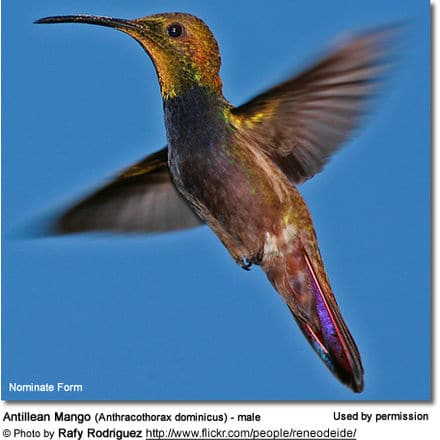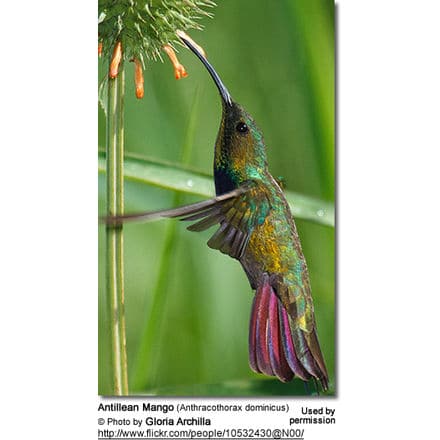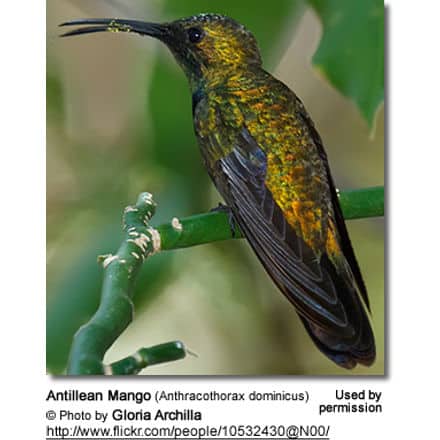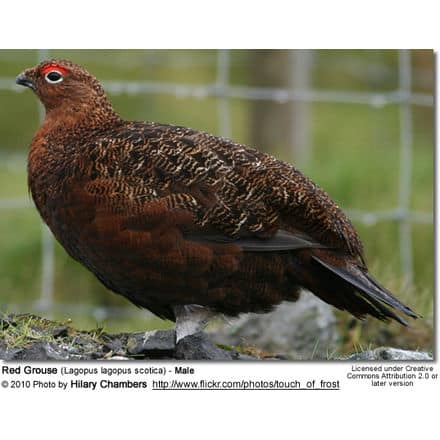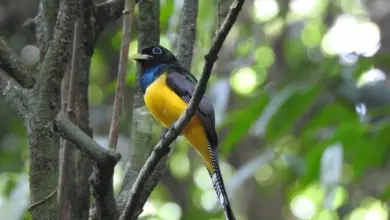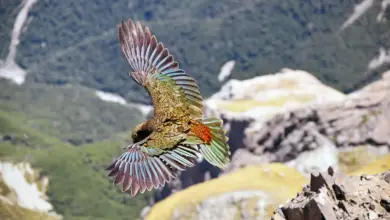Antillean Mangos
The Antillean or Dominican Mangos (Anthracothorax dominicus) – also known as Puerto Rican Golden Hummingbird – is a Caribbean hummingbird found in the Dominican Republic, Haiti, Puerto RicoPuerto Rico, the British Virgin Islands and U.S. Virgin Islands; as well as the Inagua island in the Bahamas.
Its habitats are subtropical or tropical dry or moist lowland forests, and heavily degraded former forest.
Alternate (Global) Names:
Spanish: Colibrí Dorado, Mango Antillano / Dorado, Zumbador Dorado, Zumbador Grande, Zunzún, Zumbador Grande;Italian: Mango delle Antille; French: Mango doré; German: Dominikanermangokolibri; Czech: Kolibrík antilský, kolib?ík antilský; Danish: Antillermango; Finnish: Antillienhohtokolibri; Haitian Creole French: Wanga Nègès; Japanese: usumidorimangoahachidori, usumidorimango-hachidori; Dutch: Dominicaanse Mango; Norwegian: Antillmango; Polish: weglik antylski, w?glik antylski; Russian: ????????????? ?????; Slovak: jagavicka antilská; Swedish: Antillmango
Subspecies and Distribution
-
- Antillean Mangos (Anthracothorax dominicus dominicus) (Linnaeus, 1766) – Nominate Race
- Found in Hispaniola (major island consisting of Haiti in the west and the Dominican Republic in the east) and offshore islands of Tortue, Gonve, Vache and Beata
- Dominican Mango or Puerto Rican Golden Hummingbird (Anthracothorax dominicus aurulentus) (Audebert and Vieillot, 1801)
- Found in west and central Puerto Rico and offshore islands of Culebra and Vieques, and Virgin Islands, including St Thomas, St John and Anegada
- Antillean Mangos (Anthracothorax dominicus dominicus) (Linnaeus, 1766) – Nominate Race
Description
The Antillean Mangos average 4.72 inches / 12 cm in length (including the beak and tail).
Adult Male: The male has a coppery-green upper plumage. His head has a stronger coppery sheen to it than the back. His chest is dark-blue / blackish turning brown towards the abdomen. His outer tail feathers are purplish – violet colored. In the Puerto Rican subspecies, the throat has a strong golden sheen.
Adult Female: The upper plumage is green with a bluish tint. Below she is greyish.
Juveniles look similar to the female … Immature males have a black stripe down the center of whitish underparts.
Hummingbird Resources
- Hummingbird Information
- Hummingbird Amazing Facts
- Attracting Hummingbirds to Your Garden
- Hummingbird Species
- Feeding Hummingbirds
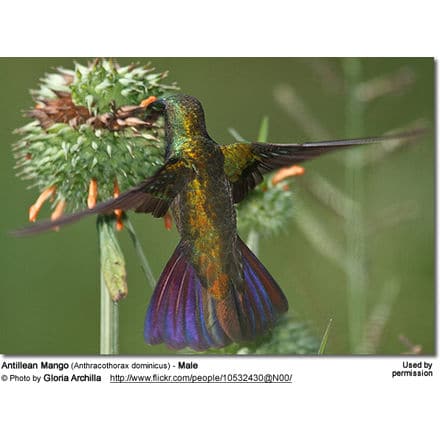
Nesting / Breeding
Hummingbirds are solitary in all aspects of life other than breeding; and the male’s only involvement in the reproductive process is the actual mating with the female. They neither live nor migrate in flocks; and there is no pair bond for this species. Males court females by flying in a u-shaped pattern in front of them. He will separate from the female immediately after copulation. One male may mate with several females. In all likelihood, the female will also mate with several males. The males do not participate in choosing the nest location, building the nest or raising the chicks.
The female is responsible for building the cup-shaped nest out of plant fibers woven together and green moss on the outside for camouflage in a protected location in a shrub, bush or tree. She lines the nest with soft plant fibers, animal hair and feather down, and strengthens the structure with spider webbing and other sticky material, giving it an elastic quality to allow it to stretch to double its size as the chicks grow and need more room. The nest is typically found on a low, thin horizontal branch.
The average clutch consists of two white eggs, which she incubates alone, while the male defends his territory and the flowers he feeds on. The young are born blind, immobile and without any down.
The female alone protects and feeds the chicks with regurgitated food (mostly partially-digested insects since nectar is an insufficient source of protein for the growing chicks). The female pushes the food down the chicks’ throats with her long bill directly into their stomachs.
As is the case with other hummingbird species, the chicks are brooded only the first week or two, and left alone even on cooler nights after about 12 days – probably due to the small nest size. The chicks leave the nest when they are about 20 days old.

Diet / Feeding
They primarily feed on nectar taken from a variety of brightly colored, scented small flowers of trees, herbs, shrubs and epiphytes. They favor flowers with the highest sugar content (often red-colored and tubular-shaped) and seek out, and aggressively protect, those areas containing flowers with high energy nectar.They use their long, extendible, straw-like tongues to retrieve the nectar while hovering with their tails cocked upward as they are licking at the nectar up to 13 times per second. Sometimes they may be seen hanging on the flower while feeding.

